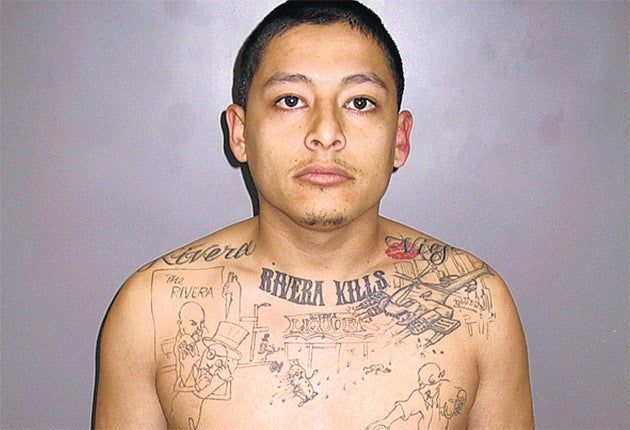The jury that found gang member Anthony Garcia guilty of murder in a Los Angeles court this week must have been pretty sure they were making the right decision: the defendant had evidence of guilt quite literally written all over him.
In a bizarre piece of detective work, which might have come straight from the pages of a crime novel, police have claimed that Garcia first came to their attention after sharp-eyed officers noticed that he had an image from the scene of an unsolved crime tattooed across his chest.
The image showed a peanut-shaped man being killed by machine gun fire from a helicopter outside a branch of the off-licence chain Ed's Liquor. Above the scene were the words "Rivera kills", which has been interpreted as a reference to a Latino street gang, Rivera-13.
Kevin Lloyd, an investigator for the LA County Sheriff's department who specialises in dealing with street violence, noticed the highly original tattoo while examining a photo that had been taken of Garcia in 2008, when he was arrested during a routine traffic stop on suspicion of driving with a suspended licence.
He promptly checked through a list of unsolved crimes in the Pico Rivera neighbourhood of East Los Angeles, and discovered that in 2004, a 23-year-old called John Juarez had been murdered outside a branch of Ed's Liquor. Photos of the crime scene revealed that his body had fallen at the same angle as the "peanut" figure in the tattoo.
When it also emerged that a streetlamp, a road sign, and a string of Christmas lights adorning the image inked below Garcia's collarbone corresponded exactly with the same crime scene, Lloyd tracked him down and had him arrested. While Garcia was in custody, undercover officers posing as fellow gang members – but carrying hidden recording devices – approached him and asked about the distinctive tattoo. To their delight, he nonchalantly informed them it portrayed his first killing.
That confession was played to a jury this week, who promptly found Garcia, 25, guilty of first degree murder. He will be sentenced in May, when under Californian law he will face an enhanced jail term because the killing was linked to gangland activity.
During the trial, prosecutors called expert witnesses to explain some of supposed symbolism which features in the tattoo. They informed jurors that the word "peanut" is often used by Latino gang members to derisively describe a rival gang member. The helicopter is believed to refer to the defendant's nickname in Rivera-13: his peers apparently call him "chopper".
Garcia is not believed to have had the tattoo done until some time after Juarez's killing. Even then, it originally portrayed only a small portion of the scene. Further elements, including the details that helped Lloyd link him to the crime, were apparently added far later.
The conviction highlights some of the reasons why, when they spot what appear to be tattoos of gang insignia on the bodies of suspects, police in Los Angeles routinely take photos of their torsos. Witnesses at crimes often recall distinctive tattoos, while prolific graffiti artists carry permanent versions of the "tag" they use.
The Sheriff's department heralded this week's conviction as the reward for inspired detective work. "Think about it. He tattooed his confession on his chest. You have a degree of fate with this," Sheriff's Captain Mike Parker told the Los Angeles Times. "Sergeant Kevin Lloyd's incredible observation of Garcia's extraordinary tattoo, combined with great investigative work is one of the reasons why sheriff's homicide investigators are known as The Bulldogs. Fate and tenacious police work brought this convicted murderer to justice."
Making a mark in gangland
Japan
Last year a member of the Yakuza gang was jailed for seven months after he entered a bath house that banned tattooed people. Tattoos have long been treated as a sign of criminality in Japan and were banned for more than half a century until 1948.
Australia
A biker was severely beaten, allegedly by members of his own gang, after having a tattoo removed that indicated loyalty to the group.
United States
White supremacist Thomas Gibison was implicated in the killing of a black handyman in Philadelphia in 1989. His involvement was allegedly an attempt to "earn" the right to have a spider web tattoo, often used by White Power groups.

Join our commenting forum
Join thought-provoking conversations, follow other Independent readers and see their replies
Comments